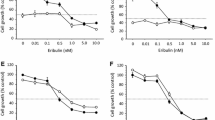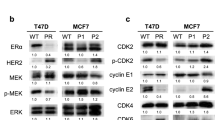Abstract
Background
A cyclin-dependent kinase (CDK) 4/6 inhibitor, palbociclib, has been used to treat patients with estrogen receptor (ER)-positive (+) and human epidermal growth factor receptor (HER) 2-negative (−) advanced breast cancer. To investigate the mechanisms underlying the antitumor activity of palbociclib, we conducted a preclinical study on the anti-cell growth and anti-cancer stem cell (CSC) activity of palbociclib in breast cancer cells.
Methods
The effects of palbociclib on Rb phosphorylation, cell growth, cell cycle progression, apoptosis, cell senescence and the proportion of CSCs were investigated in five human breast cancer cell lines of different subtypes. To investigate the mechanisms of the anti-CSC activity of palbociclib, small-interfering RNAs for CDK4 and/or CDK6 were used. Palbociclib dose-dependently reduced Rb phosphorylation and cell growth in association with G1-S cell cycle blockade and the induction of cell senescence, but without increased apoptosis, in all breast cancer cell lines.
Results
The anti-cell growth activity of palbociclib widely differed among the cell lines. Palbociclib also dose-dependently reduced the CSC proportion measured by three different assays in four of five cell lines. The inhibition of CDK4 expression, but not CDK6 expression, reduced the increased proportion of putative CSCs induced by estradiol in ER (+)/HER2 (−) cell lines.
Conclusions
These results suggest that palbociclib exhibits significant anti-cell growth and anti-CSC activity in not only ER (+) breast cancer cell lines but also ER (−) cell lines. CDK4 inhibition induced by palbociclib may be responsible for its anti-CSC activity.







Similar content being viewed by others
References
Klein ME, Kovatcheva M, Davis LE, et al. CDK4/6 inhibitors: the mechanism of action may not be as simple as once thought. Cancer Cell. 2018;34:9–20.
VanArsdale T, Boshoff C, Arndt KT, et al. Molecular pathways: targeting the cyclin D-CDK4/6 axis for cancer treatment. Clin Cancer Res. 2015;21:2905–10.
Turner NC, Slamon DJ, Ro J, et al. Overall survival with palbociclib and fulvestrant in advanced breast cancer. N Engl J Med. 2018;379:1926–36.
Dai M, Zhang C, Ali A, et al. CDK4 regulates cancer stemness and is a novel therapeutic target for triple-negative breast cancer. Sci Rep. 2016;6:35383.
Kurebayashi J, Kurosumi M, Sonoo H. A new human breast cancer cell line, KPL-1 secretes tumour-associated antigens and grows rapidly in female athymic nude mice. Br J Cancer. 1995;71:845–53.
Kurebayashi J, Otsuki T, Tang CK, et al. Isolation and characterization of a new human breast cancer cell line, KPL-4, expressing the Erb B family receptors and interleukin-6. Br J Cancer. 1999;79:707–17.
Kurebayashi J, Koike Y, Ohta Y, et al. Anti-cancer stem cell activity of a hedgehog inhibitor GANT61 in estrogen receptor-positive breast cancer cells. Cancer Sci. 2017;108:918–30.
Vijayaraghavan S, Karakas C, Doostan I, et al. CDK4/6 and autophagy inhibitors synergistically induce senescence in Rb positive cytoplasmic cyclin E negative cancers. Nat Commun. 2017;8:15916.
Baselga J, Campone M, Piccart M, et al. Everolimus in postmenopausal hormone-receptor-positive advanced breast cancer. N Engl J Med. 2012;366:520–9.
Martin LA, Pancholi S, Farmer I, et al. Effectiveness and molecular interactions of the clinically active mTORC1 inhibitor everolimus in combination with tamoxifen or letrozole in vitro and in vivo. Breast Cancer Res. 2012;14:R132.
Finn RS, Dering J, Conklin D, et al. PD 0332991, a selective cyclin D kinase 4/6 inhibitor, preferentially inhibits proliferation of luminal estrogen receptor-positive human breast cancer cell lines in vitro. Breast Cancer Res. 2009;11:R77.
Torres-Guzmán R, Calsina B, Hermoso A, et al. Preclinical characterization of abemaciclib in hormone receptor positive breast cancer. Oncotarget. 2017;8:69493–507.
Bonuccelli G, Peiris-Pages M, Ozsvari B, et al. Targeting cancer stem cell propagation with palbociclib, a CDK4/6 inhibitor: Telomerase drives tumor cell heterogeneity. Oncotarget. 2017;8:9868–84.
Shah D, Osipo C. Cancer stem cells and HER2 positive breast cancer: The story so far. Genes Dis. 2016;3:114–23.
Kurebayashi J. Resistance to endocrine therapy in breast cancer. Cancer Chemother Pharmacol. 2005;56(Suppl 1):39–46.
Nayar U, Cohen O, Kapstad C, et al. Acquired HER2 mutations in ER+ metastatic breast cancer confer resistance to estrogen receptor-directed therapies. Nat Genet. 2019;51:207–16.
Liu S, Wicha MS. Targeting breast cancer stem cells. J Clin Oncol. 2010;28:4006–122.
Lucas JJ, Domenico J, Gelfand EW. Cyclin-dependent kinase 6 inhibits proliferation of human mammary epithelial cells. Mol Cancer Res. 2004;2:105–14.
Malumbres M, Sotillo R, Santamaría D, et al. Mammalian cells cycle without the D-type cyclin-dependent kinases Cdk4 and Cdk6. Cell. 2004;118:493–504.
Acknowledgements
We thank Mrs. Kaoru Tsuboi and Megumi Kuriyama for their technical assistance. All authors read and approved the final manuscript, and agree to be accountable for the integrity of the work.
Funding
This study was partially supported by Research Project Grants from Kawasaki Medical School and MEXT/JSPS KAKENHI Grant number JP17K10566.
Author information
Authors and Affiliations
Corresponding author
Ethics declarations
Conflict of interest
J. Kurebayashi received advisory/consultation fees and research funding from Takeda Pharmaceutical Co. J. Kurebayashi also received research funding from Eisai Co. The other authors declare that they have no conflicts of interest.
Ethical approval
This article does not contain any studies with human participants or animals performed by any of the authors.
Additional information
Publisher's Note
Springer Nature remains neutral with regard to jurisdictional claims in published maps and institutional affiliations.
Electronic supplementary material
Below is the link to the electronic supplementary material.
12282_2019_1035_MOESM1_ESM.pdf
The protein expression levels of Rb and phosphorylated Rb altered by E2 and/or palbociclib in five breast cancer cell lines (a, MCF-7 cells; b, KPL-1 cells; c, BT-474 cells, d, KPL-4 cells and e, MDA-MB-231 cells). Values were analyzed after normalization to the controls and expressed as the mean ± SE. The expression level of each molecule in control cells was defined as 1. White bars, control; lightest grey bars, E2 alone; the second lightest grey bars, E2 plus 50 or 100 nM palbociclib; and the third lightest grey bars, E2 plus 100 or 500 nM palbociclib. * P < 0.05; **P < 0.01 significantly different from the E2-treated cells in ER (+) cells and from control cells in ER (-) cells. (PDF 279 kb)
12282_2019_1035_MOESM2_ESM.pdf
Effects of palbociclib on cell cycle progression in MCF-7 (a), KPL-1 (b), BT-474 (Cc KPL-4 (d) and MDA-MB-231 (e) cell lines. The values are the mean ± SE. White bars, control; lightest grey bars, E2 alone; the second lightest grey bars, E2 plus 50 or 100 nM palbociclib; and the third lightest grey bars, E2 plus 100 or 500 nM palbociclib. * P < 0.05; **P < 0.01 in comparison with cells treated with E2 alone. (PDF 252 kb)
12282_2019_1035_MOESM3_ESM.pdf
Effects of palbociclib on apoptosis in MCF-7 (a), KPL-1 (b), BT-474 (c), KPL-4 (d) and MDA-MB-231 (e) cell lines. Values are the mean ± SE. White bars, control; the lightest grey bars, E2 alone; the second lightest grey bars, E2 plus 50 or 100 nM palbociclib; and the third lightest grey bars, E2 plus 100 or 500 nM palbociclib. No significant difference was observed between palbociclib-treated and control cells. (PDF 233 kb)
12282_2019_1035_MOESM4_ESM.pdf
Effects of siRNA for CDK4 and/or siRNA for CDK6 on mRNA expression of CDK4 and CDK6 (a, b) and the proportion of CD44-high/CD24-low putative CSCs (c) in BT-474 cells. * P < 0.05; **P < 0.01 in comparison with control cells. (PDF 234 kb)
12282_2019_1035_MOESM5_ESM.pdf
Effects of siRNA for CDK4 and/or siRNA for CDK6 on mRNA expression of CDK4 and CDK6 (a, b) and the proportion of CD44-high/CD24-low putative CSCs (c) in KPL-4 cells. * P < 0.05; **P < 0.01 in comparison with control cells. (PDF 227 kb)
12282_2019_1035_MOESM6_ESM.pdf
Effects of siRNA for CDK4 and/or siRNA for CDK6 on mRNA expression of CDK4 and CDK6 (a, b) and the proportion of CD44-high/CD24-low putative CSCs (c) in MDA-MB-231 cells. * P < 0.05; **P < 0.01 in comparison with control cells. (PDF 228 kb)
About this article
Cite this article
Kishino, E., Ogata, R., Saitoh, W. et al. Anti-cell growth and anti-cancer stem cell activity of the CDK4/6 inhibitor palbociclib in breast cancer cells. Breast Cancer 27, 415–425 (2020). https://doi.org/10.1007/s12282-019-01035-5
Received:
Accepted:
Published:
Issue Date:
DOI: https://doi.org/10.1007/s12282-019-01035-5




